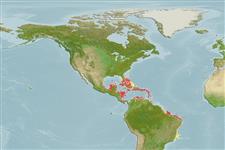>
Ophidiiformes (Cusk eels) >
Dinematichthyidae (Viviparous brotula)
Etymology: Ogilbia: Taken from Ogilby, 1887-1915, icthiologist and zoologist (Ref. 45335); suarezae: Named for Dr. Susan S. Suarez, Cornell University.
Eponymy: James Douglas Ogilby (1853–1925) was an Irish-born Australian ichthyologist and taxonomist, son of the famous zoologist William Ogilby (below). [...] Dr Susan Stevens Suarez (d: 1949) is Professor Emeritus (2017) of Biomedical Sciences, College of Veterinary Medicine, Cornell University. [...] (Ref. 128868), visit book page.
More on authors: Møller, Schwarzhans & Nielsen.
Environment: milieu / climate zone / Mức độ sâu / distribution range
Sinh thái học
Biển Cùng sống ở rạn san hô; Mức độ sâu 0 - 10 m (Ref. 57883). Tropical
Western Atlantic: widely distributed from the Gulf of Mexico and the Caribbean Sea. Appears to have a disjunct distribution: southernmost tip of the Yucatan Peninsula to Belize along the shores of Central America to Panama, and from off southernmost Florida to Haiti, Puerto Rico, Bahamas and the Antilles as far south as Dominica; so far, not known off Cuba, the Cayman Islands, Venezuela or Trinidad and Tobago.
Bộ gần gũi / Khối lượng (Trọng lượng) / Age
Chín muồi sinh dục: Lm ? range ? - ? cm
Max length : 7.5 cm SL con đực/không giới tính; (Ref. 57883)
Short description
Khóa để định loại | Hình thái học | Sinh trắc học
Các vây lưng mềm (tổng cộng) : 66 - 82; Tia mềm vây hậu môn: 48 - 63; Động vật có xương sống: 39 - 44. This species is distinguished by the following: Vertebrae 11-12 + 28-33 = 39-44, dorsal fin rays 66-82, anal fin rays 48-63; outer pseudoclasper a small triangular flap; inner pseudoclasper as long as or longer than the outer pseudoclasper, with narrow base and broad tip, penis tapering; opercular spine with single, sharp tip; scale patch on cheeks with 5-7 vertical scale rows; otolith length: height ratio 2.0-2.1, sulcus axis slightly inclined against otolith axis (Ref. 57883).
Inhabits rocky and coral reefs. A 44 mm SL female specimen (USNM 347360) contained 75 embryos, 5 mm TL, with about 8 small spots along dorsal fin base and about 6 elongate marks midlaterally; no eggs (Ref. 57883).
Life cycle and mating behavior
Chín muồi sinh dục | Sự tái sinh sản | Đẻ trứng | Các trứng | Sự sinh sản | Ấu trùng
Møller, P.R., W. Schwarzhans and J.G. Nielsen, 2005. Review of the American Dinematichthyini (Teleostei: Bythitidae). Part II. Ogilbia. aqua, J. Ichthyol. Aquat. Biol. 10(4):133-207. (Ref. 57883)
IUCN Red List Status (Ref. 130435: Version 2025-1)
Threat to humans
Harmless
Human uses
Các công cụ
Special reports
Download XML
Các nguồn internet
Estimates based on models
Preferred temperature (Tài liệu tham khảo
123201): 26.4 - 28.2, mean 27.4 °C (based on 469 cells).
Phylogenetic diversity index (Tài liệu tham khảo
82804): PD
50 = 0.5000 [Uniqueness, from 0.5 = low to 2.0 = high].
Bayesian length-weight: a=0.00389 (0.00180 - 0.00842), b=3.12 (2.94 - 3.30), in cm total length, based on all LWR estimates for this body shape (Ref.
93245).
Mức dinh dưỡng (Tài liệu tham khảo
69278): 3.3 ±0.5 se; based on size and trophs of closest relatives
Fishing Vulnerability (Ref.
59153): Low vulnerability (10 of 100).
🛈
